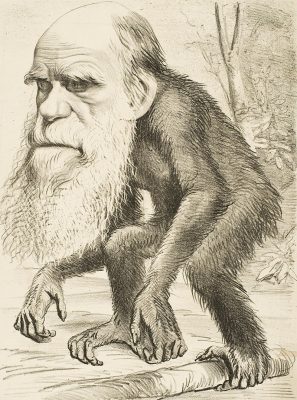“Evolution” is the process by which living organisms adapt to their environment. The concept was first substantiated and popularized by Charles Darwin in his famous book On the Origin of Species by Means of Natural Selection, or the Preservation of Favoured Races in the Struggle for Life. However, he did not call it “evolution,” and the word does not appear anywhere in the book. Instead, he termed it “transmutation.”
Darwin was a Victorian naturalist who documented his findings and discoveries while aboard the HMS Beagle from December 1831 to October 1836. Upon arriving back in England, he found that the evidence from his collection of animal specimens, fossils, and observational notes pointed to life’s diversification from one common ancestor.
Along with the artifacts he gathered, several readings led Darwin to his discovery, one of which was Charles Lyell’s Principles of Geology. Lyell believed in Uniformitarianism, the principle that natural processes that occur at present also operated in the past. Thus, one can gain a better understanding of geology from long ago gleaned through observations of current structures. First, based on the works of the geologist James Hutton, Lyell further expounded the concept in his book, which inspired Darwin while on his HMS Beagle voyage. Darwin’s various animal specimens showed how geography affected the concentration of different species. He observed that some indigenous persons from the South American island of Tierra del Fuego had barbaric tendencies while others did not, fueling his theory that humans evolved from a former species.
Another important reading that Darwin studied in 1838 while looking into his collection from the HMS Beagle was An Essay on the Principle of Population by the economist Thomas Malthus. Malthus proposed with his principle that population grew with a geometric progression while food production grew with an arithmetic progression. Geometric progression multiplied the number of people faster, causing a food deficiency over time. Darwin was interested in how the Principle of Population affected his theory on transmutation. Thus, he hypothesized that species transmuted to survive. To survive, a species must have the most advantageous traits to adapt to the environment. His thoughts were further confirmed by the paper sent by his junior, Alfred Russel Wallace, who independently learned about transmutation through his journeys to Brazil and the Malay Archipelago. Wallace had also read Malthus’ essay and was equally impacted by his reflections on the reading.
Consequently, in his 6th edition of the book On the Origin of Species, he added the term “natural selection,” which he pioneered as well as the phrase “survival of the fittest” coined by the sociologist Herbert Spencer. The idea was that life competed amongst one another in the effort to prolong the existence of their species through this process of “warring of the species .”This phenomenon could be seen in the variations of the tortoises on different islands of the Galápagos. The locals told Darwin that they had unique shell patterns according to the area that they inhabited. For example, the shells of saddle-back turtles are shaped after saddles so that they can raise their heads with ease. The adaptation stemmed from their need to eat tree cactus. On the other hand, dome-shaped tortoises do not have these kinds of shells because plants that sprout from the ground are more abundant where they live. To add to this, Darwin pointed out the distinctions in the beaks of finches from the islands.
Darwin’s research led him to the theory that all life came from one species but advanced over long periods, dividing into different species in an effort to live and multiply. He illustrated this as the structure of a tree that branches out into more variations of a single species.
In his book The Descent of Man, published in 1871, Darwin deepens his explanations to include how humans came to be, sharing their similarities to apes in terms of reproductive processes, hair, and body structure. It is implied that humans evolved from apes.
